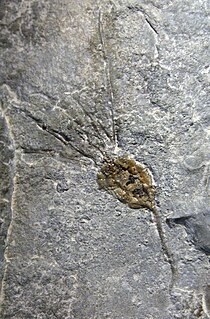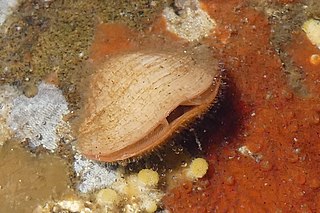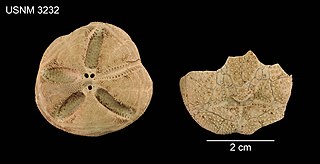
In zoology, an ambulacrum is an elongated area of the shell of an echinoderm in which a row of tube feet are arranged. [1] [2] It is pluralized as ambulacra. The area on the shell between ambulacra is known as an interambulacrum.

In zoology, an ambulacrum is an elongated area of the shell of an echinoderm in which a row of tube feet are arranged. [1] [2] It is pluralized as ambulacra. The area on the shell between ambulacra is known as an interambulacrum.

An echinoderm is any member of the phylum Echinodermata. The adults are recognisable by their radial symmetry, and include starfish, brittle stars, sea urchins, sand dollars, and sea cucumbers, as well as the sea lilies or "stone lilies". Adult echinoderms are found on the sea bed at every ocean depth, from the intertidal zone to the abyssal zone. The phylum contains about 7,000 living species, making it the second-largest grouping of deuterostomes, after the chordates. Echinoderms are the largest entirely marine phylum. The first definitive echinoderms appeared near the start of the Cambrian.

Shellfish is a colloquial and fisheries term for exoskeleton-bearing aquatic invertebrates used as food, including various species of molluscs, crustaceans, and echinoderms. Although most kinds of shellfish are harvested from saltwater environments, some are found in freshwater. In addition, a few species of land crabs are eaten, for example Cardisoma guanhumi in the Caribbean. Shellfish are among the most common food allergens.

Sea urchins are spiny, globular echinoderms in the class Echinoidea. About 950 species of sea urchin live on the seabed of every ocean and inhabit every depth zone — from the intertidal seashore down to 5,000 metres. The spherical, hard shells (tests) of sea urchins are round and spiny, ranging in diameter from 3 to 10 cm. Sea urchins move slowly, crawling with tube feet, and also propel themselves with their spines. Although algae are the primary diet, sea urchins also eat slow-moving (sessile) animals. In the food chain, the predators who eat sea urchins are the sea otter and the starfish, the wolf eel, the triggerfish, and human beings.

Starfish or sea stars are star-shaped echinoderms belonging to the class Asteroidea. Common usage frequently finds these names being also applied to ophiuroids, which are correctly referred to as brittle stars or basket stars. Starfish are also known as asteroids due to being in the class Asteroidea. About 1,900 species of starfish occur on the seabed in all the world's oceans, from warm, tropical zones to frigid, polar regions. They are found from the intertidal zone down to abyssal depths, at 6,000 m (20,000 ft) below the surface.

Sea cucumbers are echinoderms from the class Holothuroidea. They are marine animals with a leathery skin and an elongated body containing a single, branched gonad. Sea cucumbers are found on the sea floor worldwide. The number of holothurian species worldwide is about 1,717, with the greatest number being in the Asia-Pacific region. Many of these are gathered for human consumption and some species are cultivated in aquaculture systems. The harvested product is variously referred to as trepang, namako, bêche-de-mer, or balate. Sea cucumbers serve a useful role in the marine ecosystem as they help recycle nutrients, breaking down detritus and other organic matter, after which bacteria can continue the decomposition process.
Peristome is an anatomical feature that surrounds an opening to an organ or structure. Some plants, fungi, and shelled gastropods have peristomes.

Blastoids are an extinct type of stemmed echinoderm, often referred to as sea buds. They first appear, along with many other echinoderm classes, in the Ordovician period, and reached their greatest diversity in the Mississippian subperiod of the Carboniferous period. However, blastoids may have originated in the Cambrian. Blastoids persisted until their extinction at the end of Permian, about 250 million years ago. Although never as diverse as their contemporary relatives, the crinoids, blastoids are common fossils, especially in many Mississippian-age rocks.

Gogia is a genus of primitive eocrinoid blastozoan from the early to middle Cambrian.

Cothurnocystis is a genus of small enigmatic echinoderms that lived during the Ordovician. Individual animals had a flat boot-shaped body and a thin rod-shaped appendage that may be a stem, or analogous to a foot or a tail. Fossils of Cothurnocystis species have been found in Nevada, Scotland, Czech Republic, France and Morocco.

Edrioasteroidea is an extinct class of echinoderms. The living animal would have resembled a pentamerously symmetrical disc or cushion. They were obligate encrusters and attached themselves to inorganic or biologic hard substrates.
engrailed is a homeodomain transcription factor involved in many aspects of multicellular development. First known for its role in arthropod embryological development, working in consort with the Hox genes, engrailed has been found to be important in other areas of development. It has been identified in many bilaterians, including the arthropods, vertebrates, echinoderms, molluscs, nematodes, brachiopods, and polychaetes. It acts as a "selector" gene, conferring a specific identity to defined areas of the body, and co-ordinating the expression of downstream genes.
Ambulacral is a term typically used in the context of anatomical parts of the phylum Echinodermata or class Asteroidea and Edrioasteroidea. Echinoderms can have ambulacral parts that include ossicles, plates, spines, and suckers. For example, sea stars or "star fish" have an ambulacral groove on their oral side (underside). This ambulacral groove extends from the mouth to the end of each ray or arm. Each groove of each arm in turn has four rows of hollow tube feet that can be extended or withdrawn. Opposite the ambulacral groove is an ambulacral ridge on the aboral side of each ray, known as an ambulacrum. These have interambulacra between them.

Gathering seafood by hand can be as easy as picking shellfish or kelp up off the beach, or doing some digging for clams or crabs, or perhaps diving under the water for abalone or lobsters.

Brachiopods, phylum Brachiopoda, are a phylum of trochozoan animals that have hard "valves" (shells) on the upper and lower surfaces, unlike the left and right arrangement in bivalve molluscs. Brachiopod valves are hinged at the rear end, while the front can be opened for feeding or closed for protection. Two major categories are traditionally recognized, articulate and inarticulate brachiopods. The word "articulate" is used to describe the tooth-and-groove structures of the valve-hinge which is present in the articulate group, and absent from the inarticulate group. This is the leading diagnostic skeletal feature, by which the two main groups can be readily distinguished as fossils. Articulate brachiopods have toothed hinges and simple, vertically-oriented opening and closing muscles. Conversely, inarticulate brachiopods have weak, untoothed hinges and a more complex system of vertical and oblique (diagonal) muscles used to keep the two valves aligned. In many brachiopods, a stalk-like pedicle projects from an opening near the hinge of one of the valves, known as the pedicle or ventral valve. The pedicle, when present, keeps the animal anchored to the seabed but clear of sediment which would obstruct the opening.

The Ophiocistioidea is a class of extinct echinoderms from the Palaeozoic and early Mesozoic.

Abatus cordatus is a species of sea urchin in the family Schizasteridae. It is native to shallow seas surrounding certain island groups in the southern Indian Ocean. The body is protected by a hard test or shell which is covered with spines. The female broods its young in deep pockets on the upper surface, retaining the young in place with specialised spines. American zoologist Addison Emery Verrill first scientifically described A. cordatus in 1876.
Paracorynactis is a genus of corallimorphs from the western Indo-West Pacific. They are specialized predators of echinoderms, and are notable for preying on the destructive crown-of-thorns starfish among others. The genus is monotypic with the single species, Paracorynactis hoplites.
Phyllochaetopterus prolifica is a species of marine polychaete worms that live in a tube that it constructs. It is native to shallow waters in the eastern Pacific Ocean and forms colonies of tubes on rocks and submerged objects.

Aeropsidae is a family of echinoderms belonging to the order Spatangoida. It contains one extant genus. There are also eight extinct genera, most of which fall in the subfamily Corasterinae.
{{cite book}}: CS1 maint: others (link)